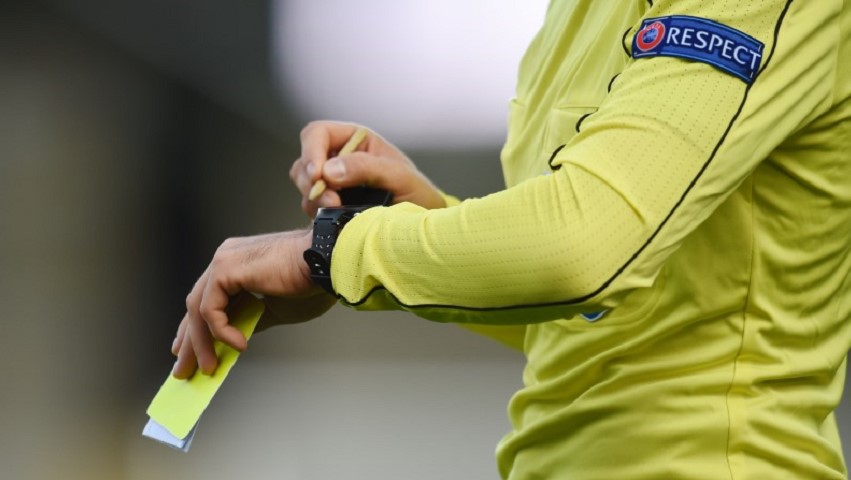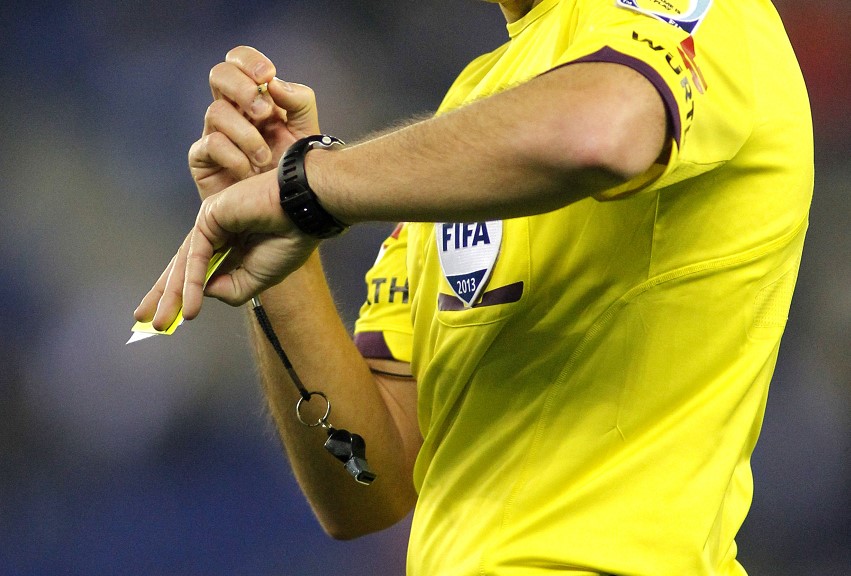
Casual fans watching FIFA on TV may notice that the game clock is going up instead of going down like in the NHL, NBA, and NFL. Sometimes there are injured players on the field and the soccer game is delayed, but the clock keeps ticking.
That seems strange. For example, an injury in a basketball game would stop the clock, but a soccer game would continue with extra overtime.
So, how long does a soccer game last, how many minutes does the action last, and why is the running clock going up instead of down? Are the game times the same for junior and professional soccer leagues?
How long is a professional soccer game?
A professional soccer game is 90 minutes of full playing time in both men’s and women’s soccer matches. It consists of two equal or two 45-minute halves.
Between each period, there is a break that lasts 15 minutes.
The IFAB (International Football Association Board) – the governing body that writes the “laws of the game” – governs professional football.
The body adds, changes, or updates the rules of the Football Association every year to ensure the safety of the players and to make the game as fun as possible for the fans.
Rule 7: The duration of the game refers to the duration of professional football matches and provides that each game consists of two 45-minute halves, plus extra time added by the referee if necessary.
How long do school and high college soccer games last?
In the event of a tie in a football match, Rule 7 provides the following rules:
- Free kicks must always be awarded, even if they extend the soccer game. Regardless of whether the penalty kick is taken in regulation time or extra time, the soccer game is overtime to allow the penalty kick to be taken.
- Two 10-minute overtimes will be played. These extra halves must follow sudden victory rules, which means that the first team to score in overtime wins the football game.
- Before extra time begins, the visiting team calls a throw-in and the winner decides whether to start with the ball or which way to go.
- If a second half is required in overtime, the teams will switch sides of the field before the start of the soccer game.
- If there is a tie at the end of the second overtime, the soccer game is considered a tie.
In the regular season, college soccer games can end in a draw after overtime. Overtime is played for postseason games, which include conference and NCAA tournament games.
Overtime will only be played if a winner is to be determined. If a college soccer game is tied after overtime has ended, the football match will go to a penalty shootout to determine who will advance.
Every high school soccer game follows state-established rules of the games, most of which are in accordance with the National Federation of State High School Associations.
A typical high school soccer game is slightly shorter than a college soccer game, with two 40-minute halves for a total of 80 minutes.
They include a 10-minute break, which can be shortened if the referee and coaches of both teams agree to shorten the time before the soccer game begins.
High school soccer games have two 10-minute overtime periods. This law for high school soccer games varies slightly from state to state.
How long do youth soccer games last?
Youth soccer leagues follow different rules compared to professional soccer games.
For example, the number of players per youth soccer games team and the number of substitutions allowed may vary by age group.
The designated playing time at youth soccer leagues also varies between individual age groups.
Here’s how the United States Youth Soccer Game Association breaks down:
- U6: four quarters of 6 minutes
- U8: four quarters of 12 minutes.
- U10: two halves of 25 minutes.
- U11 and U12: two halves of 30 minutes. (Extension: two halves of 10 minutes.)
- U13 and U14: two halves of 35 minutes. (Extension: two halves of 10 minutes.)
- U15 and U16: two halves of 40 minutes. (Extra time: two halves of 15 minutes.)
- U17, U18, and U19: two 45-minute halves (Extra time: two halves of 15 minutes.)
How long is a soccer game with a penalty shootout?
A long is a soccer match involving penalty kicks that last 172 minutes (unless the penalty kick is sudden death): 90 minutes of regular time plus 30 minutes of extra time plus 20 minutes for the 5-shot phase. It is about 2:52 hours in total.
If a tie (more commonly known as a “tie”) continues at the end of overtime, a penalty shootout will take place, with each team having five shots.
These five shots for each team are known as the initial phase of the penalty shootout.
A penalty kick is one minute fast.
Kicks from the penalty spot take 10-15 minutes for the initial 5-kick phase.
If the preliminary phase ends in a tie, the penalty shootout will be moved to the sudden death phase. The winner is the first team to advance after both teams have scored.
The sudden death phase in penalty kicks can last from 2 or 3 minutes to infinity. It depends on how long it takes for someone to miss a shot and give the opponent the lead.
How long is the break between extra time and penalties?
There is a 5-minute break between the end of overtime and penalty kicks.
During this break, players are not allowed to leave the playing field. They usually gather around each other and the coach and support those who are going to take a shot, and the goalkeeper tries to block the opposing team’s penalty kick.
Additional contemporary history
In knockout tournaments like the FA Cup and World Cup, points are required for the winning team to advance to the next round. 30 minutes of overtime at football games is now common practice. That was not the case at the beginning of football history.
If no decision is made thereafter, a replay will be required and if the two teams are not separated within 120 minutes, the outcome of the game will be determined by a coin toss.
Whether a game will be played at the European Championship or the World Cup only had to be decided when Giacinto Facetti correctly announced the coin toss in the 1968 European Championship semi-final between Italy and the Soviet Union. It was decided that a better system was needed due to the importance of the game.
As it was unfair to toss a coin or ask players to replay the game, FIFA introduced a penalty shootout to determine the winner of a football match if it was tied after 120 minutes of play. This pure football has never been a fan of penalty shootouts.
In the 1990s, FIFA introduced the “golden goal” in overtime in football matches. FIFA hoped to automatically win more offensive games by implementing a sudden-death scenario where the first team to score in overtime would automatically win.
That means less punishment. But a few years later, the new law was revised and repealed.
How do additional courses work?
When the referee blows the whistle to signal the end of regular time, players and managers gather on the field to rehydrate and discuss overtime tactics. The extra time is 30 minutes and is again divided into 2 halves.
If necessary, overtime will be added to each half of the extra time. In the event of an interruption, the exchange of commands stops immediately.
There is no half-time break in extra time. If the football game ends in a draw after extra time, the game will be decided by a penalty shoot-out.
The longest football game in history
On March 30, 1946, Stockport County and Doncaster Rovers played the longest game of professional football at Edgeley Park.
This game, which lasted three hours and 23 minutes, is a world record in the history of modern football.
The Northern Third Division Cup replay followed a 2-2 first-leg draw that lasted just 90 minutes. 203 minutes passed in the replay without a winner.
After 90 minutes (two halves of 45 minutes) the game between Stockport and Doncaster was again tied 2-2.
Then the soccer game went into extra time, but 30 minutes wasn’t enough.
Penalty shootouts, coin tosses, and, in this case, ‘play to win’ were used before the soccer match started to determine the winner after 120 minutes of deadlocked play.
It was the “golden goal” form of English war football in the 1940s when the next goal was scored.
The longest women’s soccer games last 168 hours and were played by SF Winterbach and TGIF-EC Wallhalben (both Germany) in Winterbach, Germany, from May 29 to June 5, 2019.
In the end, SF Winterbach scored 1797 points in favor of TGIF-EC Wallhalben. 1830. This Guinness World Record was an initiative to promote women’s football.
Why do soccer clocks count up and not down?
During the football game, when the game starts, the clock continues to count down to minimize game disruption. This means penalties, tilts, throwing the ball into the field when the ball goes out, and other things that don’t stop the game clock.
Since the clock doesn’t stop unless the game needs to stop, there’s no point in starting the countdown and reaching zero or a negative number.
Another reason why the clock ticks down instead of down is because the referee maintains control of the game. The referee can measure all time-wasting points and add them to the game at the end of the half.
Giving the referee this control allows them to focus on the game instead of stopping and restarting the clock.
FAQ
Are there any timeouts during a soccer match?
There are no time-outs during a football game, but teams can be substituted. Only three players may be substituted during a professional football game.
However, due to the Covid-19 situation, teams can make up to five substitutions during a game.
How long is a Major League Soccer game?
In the Premier League, matches last 90 minutes divided into 45-minute halves, just like in international leagues like FIFA.
Time requires a 15-minute break from the game. Finally, overtime is added to the game clock for each half.
Why do soccer games go over 90 minutes?
The extra time is in addition to 90 minutes of playing time in football. If the game is interrupted, the referee can add extra time at the end of each half.
Examples of injury time include injury time when an injured player needs help off the field, goal celebrations, ball outs, fouls, and more.
How long is a professional soccer game halftime?
A typical professional soccer match consists of two 45-minute periods with a 15-minute halftime. Each football league may have different times. Youth leagues usually have shorter periods.
How long is a soccer match including half-time?
Each long soccer game lasts a total of 90 minutes. After 45 minutes or 90-minute halves, the referee stops play for a break or half-time break.
After the break, the referee restarts the soccer games and the second half begins.
Is a soccer game 120 minutes?
Live soccer games are at least 105 minutes long. Two 45-minute halves and one-half of 15 minutes. However, they will usually be a bit longer due to the extra time.
Why do they add 5 minutes in soccer?
Even if the scoreboard clock is on, the referee keeps the official clock on the field of play. It adds extra minutes at the end of each half of your game – commonly known as “overtime” or “overtime” – due to delays that occur during the half.
How many minutes are in a high school soccer game?
High school soccer game – two forty-minute halves with a 10-15 minute half. A total of 80 minutes of football was played.
How long is a soccer game for middle school?
According to the IFAB Rules of Play, most middle school soccer games consist of two 30- or 35-minute halves. As such, they typically span 60 to 70 minutes of gameplay.
Conclusion
In this post, we found out how long a soccer game lasts. The answer is usually like this: 90 minutes are divided into two 45-minute halves with 15-minute intervals plus stoppage time.













